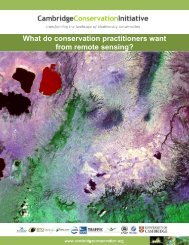CONSERVING BIODIVERSITY & DELIVERING ECOSYSTEM SERVICES
conserving biodiversity & delivering ecosystem services
conserving biodiversity & delivering ecosystem services
You also want an ePaper? Increase the reach of your titles
YUMPU automatically turns print PDFs into web optimized ePapers that Google loves.
Spiny Babbler<br />
(Jyotendra Jyu Thakuri)<br />
Knowledge of the bird fauna of Nepal’s IBAs is still<br />
incomplete. However, an amazing 547 bird species has been<br />
recorded from Chitwan National Park IBA. The network of IBAs<br />
in Nepal is known to be home to some 30 globally threatened<br />
bird species and includes important populations of Nepal’s<br />
only endemic bird species, Spiny Babbler.<br />
Although it is the bird fauna that defines the IBA network, the<br />
conservation of these sites should help ensure the survival of<br />
a correspondingly large number of species in other groups.<br />
For example, lowland IBAs such as Chitwan National Park,<br />
Bardia National Park and Suklaphanta Wildlife Reserve<br />
support globally threatened large mammals such as Indian<br />
Rhinoceros, Tiger and Asian Elephant and reptiles including the Mugger Crocodile and Gharial. High altitude IBAs, for example,<br />
Kanchenjunga Conservation Area, Shey Phoksundo National Park and Langtang National Park also harbour globally threatened<br />
mammals such as Snow Leopard, Himalayan Tahr and Himalayan Musk Deer. The Mai Valley IBA in east Nepal is a hotspot for<br />
medicinal and aromatic plants.<br />
<br />
Many important ecosystem services are delivered across the network of 27 IBAs. For example, water provision is delivered at all<br />
the IBAs and has been identified as the most important service for 90% of them. Harvested wild goods, including food, fibre,<br />
natural medicines and fuelwood for cooking and heating, recreation/tourism and global climate regulation are also recorded as<br />
being of high importance across the majority of sites. Local climate and air quality regulation, erosion control, spiritual/religious<br />
experience, reducing the impact of weather events and improving water quality are also delivered by ecosystems in most sites,<br />
though are generally considered of lesser importance (see figure, and p.35 for information on assessing ecosystem services<br />
using a rapid appraisal).<br />
Proportion of IBAs delivering different ecosystem services and their relative importance<br />
SOURCE Based on information provided at an expert consultation workshop.<br />
An example from Shivapuri Nagarjun National Park IBA<br />
Shivapuri Nagarjun National Park is an IBA near Kathmandu, the capital of Nepal. It is mostly forested, with over 300 species<br />
of bird and more than 20 species of mammal recorded. The forests are a carbon store and so contribute to global climate<br />
regulation, and the park is well used for recreational activities. However, water is undoubtedly the most important service,<br />
as the park provides nearly 60% of the annual freshwater requirements of 2.5 million people.<br />
“The Government of Nepal had the foresight to designate the watershed as a National Park in 2002. Now we can all<br />
appreciate its value for biodiversity and a range of other ecosystem services” says Gopal Bhattarai, Warden. “It’s vital<br />
that we manage this protected area carefully, for the benefit of both local and downstream communities”.<br />
For more details of this study, see p.28.




